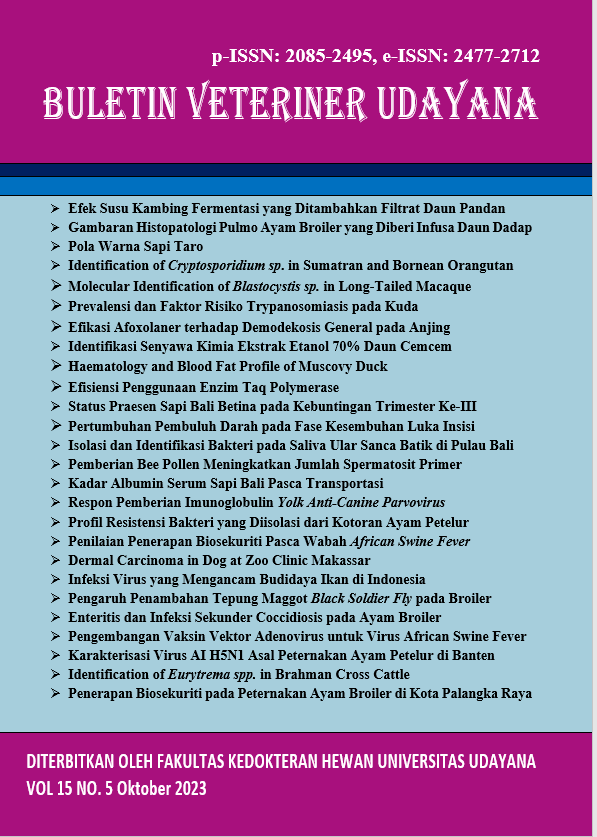HUMANE EDUCATION AND CHILD CHARACTER DEVELOPMENT: A CONCEPTUAL REVIEW OF CORRELATION BETWEEN ANIMAL WELFARE EDUCATION AND PROSOCIAL BEHAVIOR
Abstract
Humane education is an educational program that does not only focus on supporting the animal’s well-being but also generally gives positive impacts on children’s character development. Characters were born from the process of learning and habit practices that were carried out at early age. Therefore, character education should be taught early. Positive character development in children, for example, empathy and compassion, will contribute to the emergence of prosocial behavior. This could become preventive action or solution to anticipate the increasing violence trend that is directed either to humans, animals or, the environment.
Downloads
References
Asih GY, Pratiwi MMS. 2010. Perilaku prososial ditinjau dari empati dan kematangan emosi. J. Psikologi 1(1): 33-42.
Balcombe J. 2016. What a fish knows: The inner lives of our underwater cousins. New York, NY: Macmillan.
Bekoff M. 2013. Why dogs hump and bees get depressed: The fascinating science of animal intelligence, emotions, friendship, and conservation. Novato, CA: New World Library.
Decety J, Bartal IB, Uzefovsky F, Knafo-Noam A. 2016. Empathy as a driver of prosocial behavior: highly conserved neurobehavioral mechanisms across species. Philos. Trans. R. Soc. Lond. B. Biol. Sci. 371(1686): 20150077.
Elo S, Kaarianinen M, Kanste O, Polkki R, Utriainen K, and Kyngas H. 2014. Qualitative Content Analysis: A focus on trustworthiness. Sage Open. 4: 1-10.
Imah MT, Purwoko B. 2017. Studi kepustakaan penerapan konseling neuro linguistic program (nlp) dalam lingkup pendidikan. J. Mahasiswa Bimbingan Konseling UNESA. 8(2): 10-19.
Itle-Clark S. 2011. Humane education beyond the shelter: Developing humane pedagogy. The Packrat. 3: 1-6.
Juliadilla R. 2010. Humane education as a method of emphaty character for children in school. WASKITA: J. Pend. Nilai Pembangunan Karakter. 4(2): 101-112.
Kuhlthau CC. 2002. Teaching the library research. USA: Scarecrow Press Inc.
McDonald N, Messinger D. 2011. The Development of Empathy: How, When, and Why. University of Miami Department of Psychology, USA. Pp. 1-36.
Acerbi J, Lombo A, Sanguineti JJ (Eds.), Free Will, Emotions, and Moral Actions: Philosophy and Neuroscience in Dialogue. IF-Press.
Ormrod JE. 2008. Psikologi Pendidikan Membantu Siswa Tumbuh dan Berkembang Edisi Keenam Jilid 2. Jakarta: Erlangga.
Piek JP, Kane R, Rigoli D, McLaren S, Roberts CM, Rooney R, Jensen L, Dender A, Packer T, Straker L. 2015. Does the Animal Fun program improve social-emotional and behavioural outcomes in children aged 4-6 years? Hum. Mov. Sci. 43: 155-163.
Prastowo A. 2012. Metode Penelitian Kualitatif Dalam Perspektif Rancangan Penelitian. Jogjakarta: Ar-ruzzmedia.
Roberts W, Strayer J. 1996. Empathy, Emotional Expressiveness, and Prosocial Behavior. Child Develop. 67: 449‒470.
Samuels WE, Meers LL, Normando S. 2016. Improving upper elementary students’ humane attitudes and prosocial behaviors through an in-class humane education program. Anthrozoös. 29(4): 597–610.
Sarwono J. 2006. Metode Penelitian Kuantitatif dan Kualitatif. Yogyakarta: Graha Ilmu.
Scott J, Marshall G. 2015. A Supplementary Dictionary of Social Research Methods. Oxford University Press.
Susanto W, Gandha MV. 2015. Pusat edukasi tentang hewan peliharaan di Kelapa Gading. J. Kajian Teknol. 11(1): 28-42.
Sprinkle JE. 2008. Animals, empathy, and violence: Can animals be used to convey principles of prosocial behavior to children? Youth Viol. Juvenile Justice. 6(1): 47–58.





